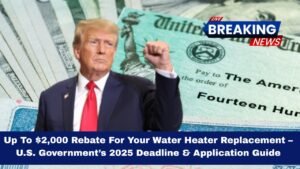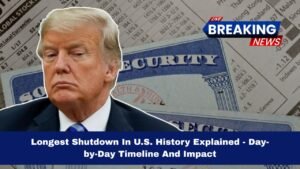Former President Donald Trump has announced his plan to give $2,000 payments to middle- and lower-income Americans.
He said the money would come from the tariff revenues collected through taxes on imported goods. Trump shared this during a recent speech, calling it a “dividend” for hardworking Americans.
What Trump Said
Trump explained that the payments would go to people with middle or low incomes, while high-income earners would be excluded.
He also mentioned that the remaining money from the tariffs would be used to reduce the national debt. However, his administration has not released any detailed plan or timeline yet.
The idea is based on Trump’s claim that tariffs have brought in “trillions” of dollars to the U.S. economy. But experts say this number is much smaller. Reports suggest that by the end of September 2025, total tariff revenue was around $195 billion, not trillions.
Who Could Qualify
According to Trump’s statement, people with low or middle incomes may receive the $2,000 payment. But he has not clearly defined what income levels count as “high” or “low.” This makes it difficult to know exactly who would be eligible.
Here’s what is known and what is still unclear:
| Details | Information |
|---|---|
| Payment amount | $2,000 per eligible American |
| Eligibility | Middle and lower-income groups |
| High-income exclusion | Yes, but limit not defined |
| Funding source | U.S. tariff revenue |
| Timeline | Not announced yet |
| Approval | Not confirmed by government |
The Cost of the Plan
Economists have calculated that giving $2,000 to most American adults would cost nearly $300 billion. But the current tariff revenue is much lower than that. This raises a big question—where will the rest of the money come from?
Experts at several policy groups have said that even if tariffs continue to collect more money, they may not be enough to fund such large payments without affecting the economy. Some analysts also warn that tariffs can make imported goods more expensive, which could raise prices for consumers.
Could It Be a Tax Cut Instead?
Some officials have hinted that the payments might come in other forms instead of cash checks. The government could offer tax cuts or rebates that help people save the same amount. This would reduce government spending while still benefiting middle-class Americans.
Possible options could include:
- Lowering or removing tax on overtime or tips.
- Allowing deductions for certain expenses, like auto loans.
- Reducing income tax for middle-income families.
What Experts Think
Economic experts have mixed opinions. Some say it’s a smart idea to give people a financial boost, especially during a period of rising prices. Others believe it’s unrealistic because tariff income is not enough to support $2,000 checks for millions of people.
Another issue is that tariffs often lead to higher prices for everyday products like food, electronics, and vehicles. So while people might get a $2,000 check, they could end up spending more on goods, reducing the real benefit of the payment.
What Happens Next
As of now, the $2,000 payment plan is just a proposal. The administration has not confirmed how or when it will happen.
More details about income limits, payment dates, and distribution methods are expected if the plan moves forward. Until then, Americans should wait for official government updates before expecting any payments.
Donald Trump’s $2,000 check plan sounds appealing to many working families, but it faces many challenges. Without clear details or enough funding, it remains uncertain whether the plan will ever be launched.
While it could provide real help for lower-income Americans, the big question is how the government can afford it without increasing the national debt or raising prices.
FAQs
Who will get the $2,000 check?
Only middle- and lower-income Americans are expected to qualify. High-income earners will likely be excluded, but income limits are not announced.
When will the payments start?
There is no confirmed date yet. The plan is still under discussion, and no official schedule has been released.
Will the payments affect taxes or prices?
Possibly yes. Experts say tariffs could make imported goods more expensive, and the payments might be replaced with tax cuts instead of direct checks.




